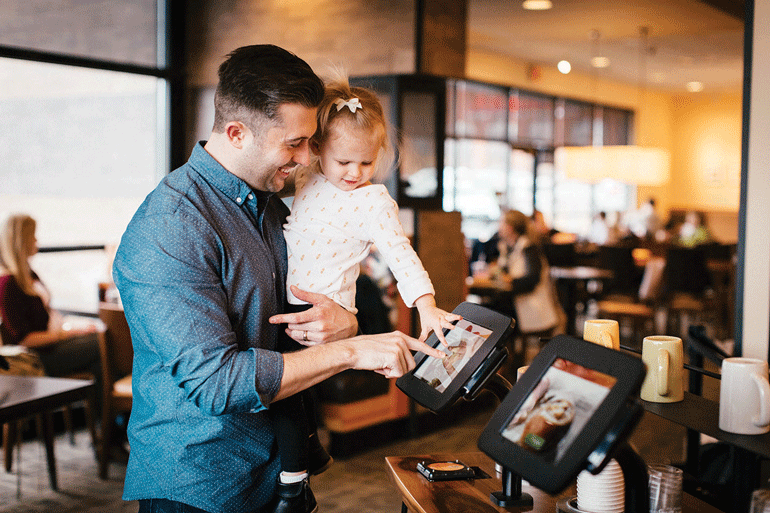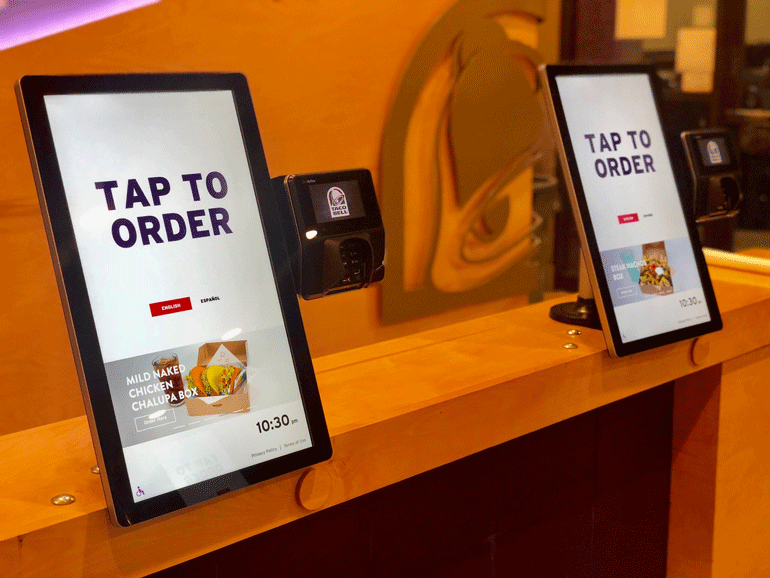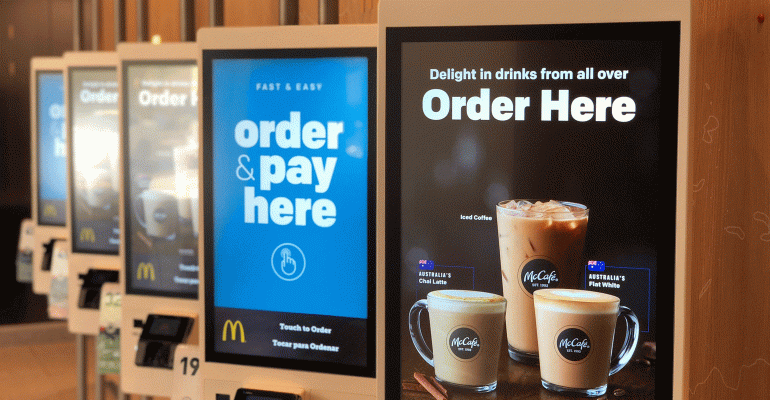A little over a year ago, Saladworks executive Jena Henderson watched lines snake towards the door at a Wayne, Penn. store.
Lines are normally a good sign.
But Henderson also observed something that made her cringe. Instead of waiting on the line, customers turned on their heels and left the restaurant.
At that moment, Henderson realized the solution to the chain’s lunch surge — kiosks.
“If I can peel off some of the people in that line who get the same thing every time, maybe I can shorten that line, and not lose people,” she said.
After a year of beta testing, Saladworks is close to installing a bells-and-whistles kiosk system at a handful of locations in the coming weeks. The 90-unit Conshohocken, Penn.-based company is among an avalanche of limited-service operators, primarily emerging chains, adding self-serve ordering machines for busy Gen Xers and swipe-and-click loving millennials.

Saladworks is close to installing a kiosk system at a handful of locations.
Kiosks are certainly not new. Operators have been toying with pedestal- and wall-mounted ordering stations for several years including Panera Bread, Johnny Rockets and McDonald’s restaurants in Europe. But now the self-serve tech is moving into a next generation phase with kiosks able to recall past orders, automate loyalty rewards and allow facial recognition payment.
“We’re doing things today that were impossible two years ago,” innovation expert Daniel Burrus said at this year’s National Restaurant Association show.
“And, if you don’t do it, someone else will.”
Mark Berinato, vice president of digital experience at Panera Bread, said kiosks have proven to increase check averages because devices are programmed to upsell consistently, unlike a human.
Panera Bread would not disclose details about check averages. However, the company estimates its digital sales (online, mobile, kiosks, rapid order pickup and delivery) to reach $1.7 billion by the end of 2018, which represents about 31 percent of total sales.
At Panera Bread, frequency was an unexpected benefit the company hadn’t anticipated when the St. Louis-based bakery-cafe chain installed kiosks in 2014.

Panera Bread launched kiosks in 2014.
At the beginning, it was skip the line technology.
“It was about speed. It was about efficiency. It was about taking someone with an hour lunch, and giving them a few minutes back,” Berinato said.
All of those things proved to be true, but the self-serve devices are also driving loyalty.
“Kiosk customers come back more frequently,” he said.
Many critics of restaurant automation say operators are replacing humans with technology amid challenging labor issues ranging from mandatory minimum wage increases to high turnover.
Most operators will argue that’s not entirely true.
“It’s not a labor savings tactic by any means,” Burger Boss founder Mo Farha said. “It’s about giving the Millennials control.”
Burger Boss has six locations in Southern California, and its kiosk orders are about $2 more than checks made at the counter.
But Square Roots Kitchen’s founder Derin Alemli said his cashier-less business became cash flow positive in three months because he’s using less labor.
“We’re eliminating that aspect of the business,” he said of cashiers.
Square Roots Kitchen is outfitted with five, 32-inch wall mounted touchscreen tablets. There are no cashiers.
He says most shifts require half the staff of a standard no-kiosk restaurant. And, that savings enables him to provide customers food made with premium ingredients but at reasonable price.
J.R. Galardi, president of Irvine, Calif.-based Wienerschnitzel, has a different take on kiosks.
So far, he’s not convinced about the benefit of kiosks as he’s seen many kiosks go untouched; or, when they are used, there’s always an extra employee hanging out to assist customers.
“It just looks like it takes more labor,” said Galardi, whose father founded the 330-unit chain 57 years ago.
“I don’t know if kiosks are the way to go. To me, the phone is the way to go.”

Taco Bell has been testing kiosks in Southern California and Indianapolis.
Galardi makes another point: When you’re a national brand, adopting sophisticated technology is costly because it comes with licensing fees per kiosk.
Emerging brands like Square Roots Kitchen and Burger Boss are quicker to adapt because they’re small in scale and flexible.
But for mega-chains, rolling out complex devices to hundreds of units can be a slippery — and dangerous — slope.
One glitch can send loyal customers running.
The largest chains making headway with kiosks include McDonald’s and Panera Bread.
McDonald’s has installed kiosks in 4,000 of its 14,000 U.S. restaurants.
The self-ordering machines are part of the company’s redesigned Experience of the Future restaurants. McDonald’s said 3,000 more restaurants in the U.S. will adopt the new look, which includes kiosks, by the end of the year.
Panera Bread launched kiosks in 2014.
Four years later, about half of the chain’s 2,200 units sport kiosks. More are coming by the end of this year, concentrated mostly in franchise locations.
Berinato said adding kiosks at such a large scale takes time, especially when you’re making tweaks along the way to improve. Updated versions of the Panera kiosk has included “curated menus” that sort by dietary choices such as a “protein rich” meals, he said.
The same goes for Saladworks. The 32-year-old brand, which makes salads center of the plate, has been testing a kiosk for about a year in Philadelphia.
An updated version is set to roll out later this summer in a few restaurants. The new version is customized to meet the specific needs of Saladworks’ core customer, who often have special dietary demands, Henderson said.
Similar to Panera Bread, the kiosk will have a navigational tool called the “Life Bar” that sorts the menu by dietary choices such as “gluten free” or “high protein.” The kiosk will also remember past orders when a customer swipes a credit card. If you’re a loyalty member, customers can enter their phone number or scan a barcode from the Saladworks app to pull up past orders.
Henderson said testing is crucial.
“It is technology. I want to make sure nothing explodes,” she said.
Testing is ongoing at Irvine, Calif.-based Taco Bell and Subway.
The two fast food giants are rarely talked about in the same breadth. Taco Bell is a culture-driven, innovative brand adored by Millennials; by comparison, Subway is struggling and downsizing its U.S. operations.

Subway is testing kiosks in about 150 restaurants.
Yet both have been cautious when it comes to rolling out kiosks.
Subway is testing kiosks in about 150 restaurants.
But brand leaders don’t want technology to come at the expense of wiping out Subway’s assembly-line roots.
“What makes Subway special is that interaction between the sandwich artist and the guest,” said James Walker, vice president of development.
“I’m not in any way making light of the importance of consumer facing technology, and we’re very committed to being best in class. But when I think of Subway, and what brings a smile on my face, is that guest having interaction with that sandwich artist. That interaction will still remain one of our core strengths from time come.”
Taco Bell has a different concern. They’ve been testing kiosks in Southern California and Indianapolis. The Irvine, Calif. test has been ongoing for more than a year. In that time, the self-serve stations have gone from a bank of small tablets to big touchscreens displays.
Other kiosk iterations have gradually been added for test at seven other company restaurants in their home base of Orange County, Calif.
Taco Bell spokesman Rob Poetsch makes no apologies for the slow adoption.
“We’re still testing and learning and figuring out where is the optimal place to put them, and configuration with the order counter,” he said.
With more than 6,400 U.S. units, the kiosks must be a “seamless fast experience,” he said.
And, if that means Taco Bell isn’t a leader on this one, that’s OK.
“We’ve had a lot of firsts. We were one of first mobile ordering with an app. We want this to be good restaurant experience. We’re going to do it right,” he said.
Contact Nancy Luna at [email protected]
Follow her on Twitter: @FastFoodMaven





